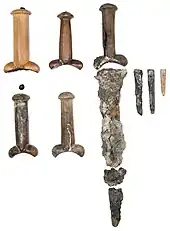Bollock dagger
A bollock dagger or ballock knife is a type of dagger with a distinctively shaped hilt, with two oval swellings at the guard resembling male testes ("bollocks"). The guard is often in one piece with the wooden grip, and reinforced on top with a shaped metal washer. The dagger was popular in Scandinavia, Flanders, Wales, Scotland and England between the 13th and 18th centuries, in particular the Tudor period. Within Britain the bollock dagger was commonly carried, including by Border Reivers, as a backup for the lance and the sword. Many such weapons were found aboard the wreck of the Mary Rose. The bollock dagger is the predecessor to the Scottish dirk.


In the Victorian period, weapon historians introduced the term kidney dagger, due to the two lobes at the guard, which could also be seen as kidney-shaped, in order to avoid any sexual connotation.[1] The hilt was often constructed of box root (dudgeon) in the 16th and 17th centuries, and the dagger was sometimes called a dudgeon dagger or dudgeonhafted dagger in this period. The Bollock dagger was often used during Shakespeare's time and was only permitted to be carried by men. This dagger was most commonly used as a backup weapon for a sword or spear. The dagger first started appearing on continental effigies around 1300–1350, and has one of the longest usage periods of any of the five main types of medieval daggers.[2]
References
- Blair, C. (1962). European and American Arms c. 1100—1800. B. T. Batsford, London.
- "Spotlight: The Bollock Dagger". Archived from the original on 12 October 2007. Retrieved 29 March 2021.